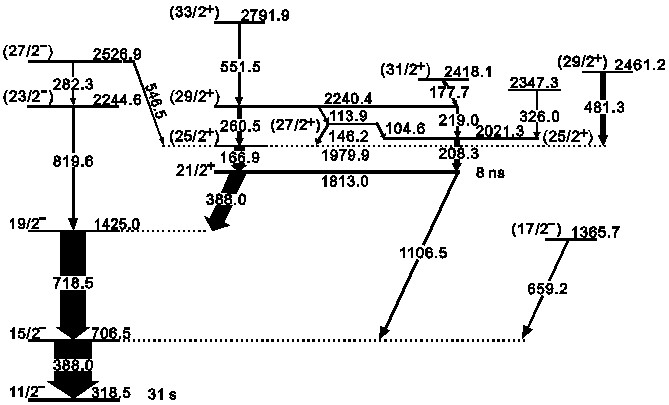Researchers at Institute of Modern Physics, Chinese Academy of Sciences ( IMP ) succeeded in studying high-spin states in 195Au using the Joined-In Beam Gamma Equipment of the HI-13MV Tandem Accelerator Laboratory at China Institute of Atomic Energy In Beijing ( CIAE ).
The study via the 192Os ( 7Li, 4n ) reaction at a beam energy of 44 MeV populates the excited states of 195Au. With a detector array consisting of 12 Compton-suppressed high-purity germanium ( HPGe ) detectors and two low-energy photon spectrometer detectors, X-γ-t and γ-γ-t coincidence measurements were performed in the optimum energy. Based on above measurements, a level scheme consisting of 15 new transitions and 10 new levels is established for 195Au ( see fig.1 ).
Then, the researchers investigate the triaxial shape-polarizing effect of the high-j  proton hole using total routhian surface (TRS) calculations. By comparing with the level structures in the odd-A Au isotopes and the even-even core Hg nuclei, the result in figure 2 showed the lowest ( −,−1/2 ) configuration in odd-A 189-197Au at
proton hole using total routhian surface (TRS) calculations. By comparing with the level structures in the odd-A Au isotopes and the even-even core Hg nuclei, the result in figure 2 showed the lowest ( −,−1/2 ) configuration in odd-A 189-197Au at  =0.127MeV. The minima in TRS plots should correspond to the
=0.127MeV. The minima in TRS plots should correspond to the  bands. The calculations indicate that the quadrupole deformation slightly decreases and the triaxial deformation evolves toward oblate shape as the mass number increases. It notes that the ground state in the even-even Hg core nuclei tends to have a near oblate shape. These configurations are proposed to the rotational bands and three-quasiparticle states observed in 195Au.
bands. The calculations indicate that the quadrupole deformation slightly decreases and the triaxial deformation evolves toward oblate shape as the mass number increases. It notes that the ground state in the even-even Hg core nuclei tends to have a near oblate shape. These configurations are proposed to the rotational bands and three-quasiparticle states observed in 195Au.
The results have been published in Physical Review C 85, 027301 (2012).
The article can be linked as follows: http://prc.aps.org/abstract/PRC/v85/i2/e027301

fig.1 Level scheme of 195Au deduced from the present work. (Image by IMP)

fig.2 Total routhian surfaces at =0.127MeV calculated for the lowest ( π,α ) = ( −,−1/2 ) configurations in 189–197Au.
(Image by IMP)

